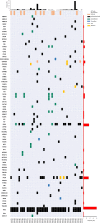Genomic Features for Therapeutic Insights of Chemotherapy-Resistant, Primary Mediastinal Nonseminomatous Germ Cell Tumors and Comparison with Gonadal Counterpart
- PMID: 30659078
- PMCID: PMC6459248
- DOI: 10.1634/theoncologist.2018-0430
Genomic Features for Therapeutic Insights of Chemotherapy-Resistant, Primary Mediastinal Nonseminomatous Germ Cell Tumors and Comparison with Gonadal Counterpart
Abstract
Primary mediastinal nonseminomatous germ cell tumors (PMNSGCT) frequently become refractory to chemotherapy, and no effective salvage therapy exists. We performed genomic profiling on a series of 44 PMNSGCT and compared the results with those from chemorefractory, metastatic pure seminomatous (Sem, n = 22) and nonseminomatous (NS, n = 86) testicular germ cell tumors. Archival tissues were sequenced by a hybrid capture-based technology (FoundationONE; Foundation Medicine, Inc., Cambridge, MA). Microsatellite instability (MSI) and tumor mutational burden (TMB, mutations [mut]/Mb) were determined.Statistically significant differences in genomic alterations (GA) of PMNSGCT versus NS included higher TP53 pathway GA (p < .0001), PIK3CA pathway GA (p < .0001), and lower cell-cycle pathway GA (p = .0004). There were no MSI-high PMNSGCT cases. Mean TMB was similar between the groups, but there were more ≥10 mut/Mb in the PMNSGCT group versus NS (11.4% vs. 4.6%).The GA identified in PMNSGCT were similar to the findings from NS, with differential opportunities for targeted therapies and immunotherapies. Further study of precision treatments appears warranted.
© AlphaMed Press 2019.
Conflict of interest statement
Disclosures of potential conflicts of interest may be found at the end of this article.
Figures

References
-
- International Prognostic Factors Study Group , Lorch A, Beyer J et al. Prognostic factors in patients with metastatic germ cell tumors who experienced treatment failure with cisplatin‐based first‐line chemotherapy. J Clin Oncol 2010;28:4906–4911. - PubMed
-
- Necchi A, Bratslavsky G, Corona RJ et al. Comprehensive genomic characterization of chemotherapy‐resistant testicular germ cell tumors (TGCT). J Clin Oncol 2018;36(suppl 15):4555a.
-
- Adra N, Einhorn LH, Althouse SK et al. Phase II trial of pembrolizumab in patients with platinum refractory germ‐cell tumors: A Hoosier Cancer Research Network Study GU14‐206. Ann Oncol 2018;29:209–214. - PubMed
Publication types
MeSH terms
Substances
Supplementary concepts
LinkOut - more resources
Full Text Sources
Medical
Research Materials
Miscellaneous

